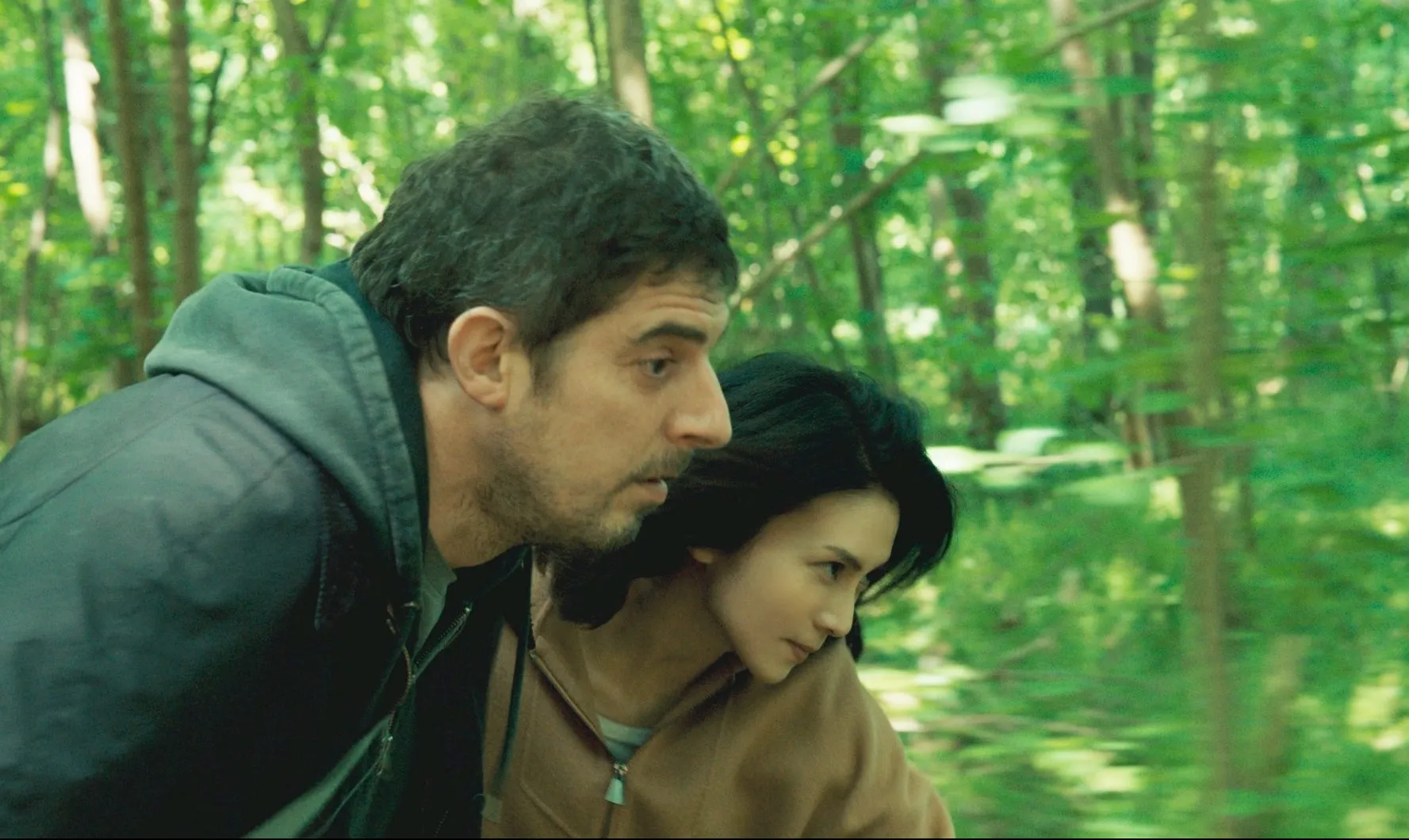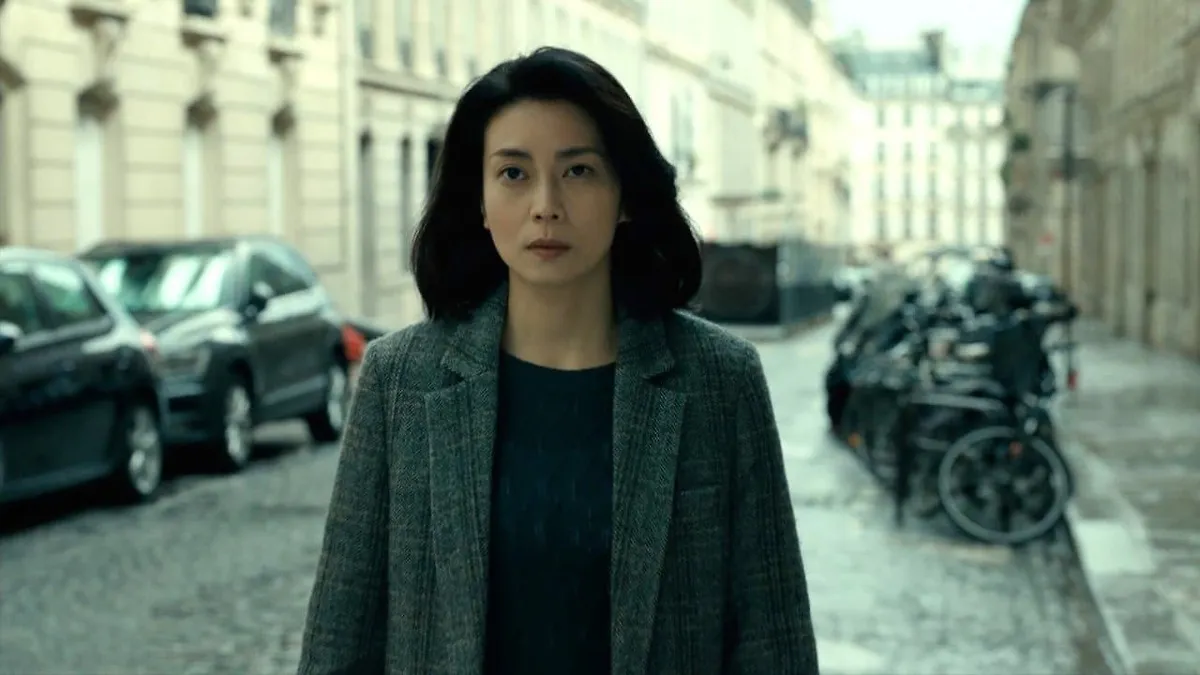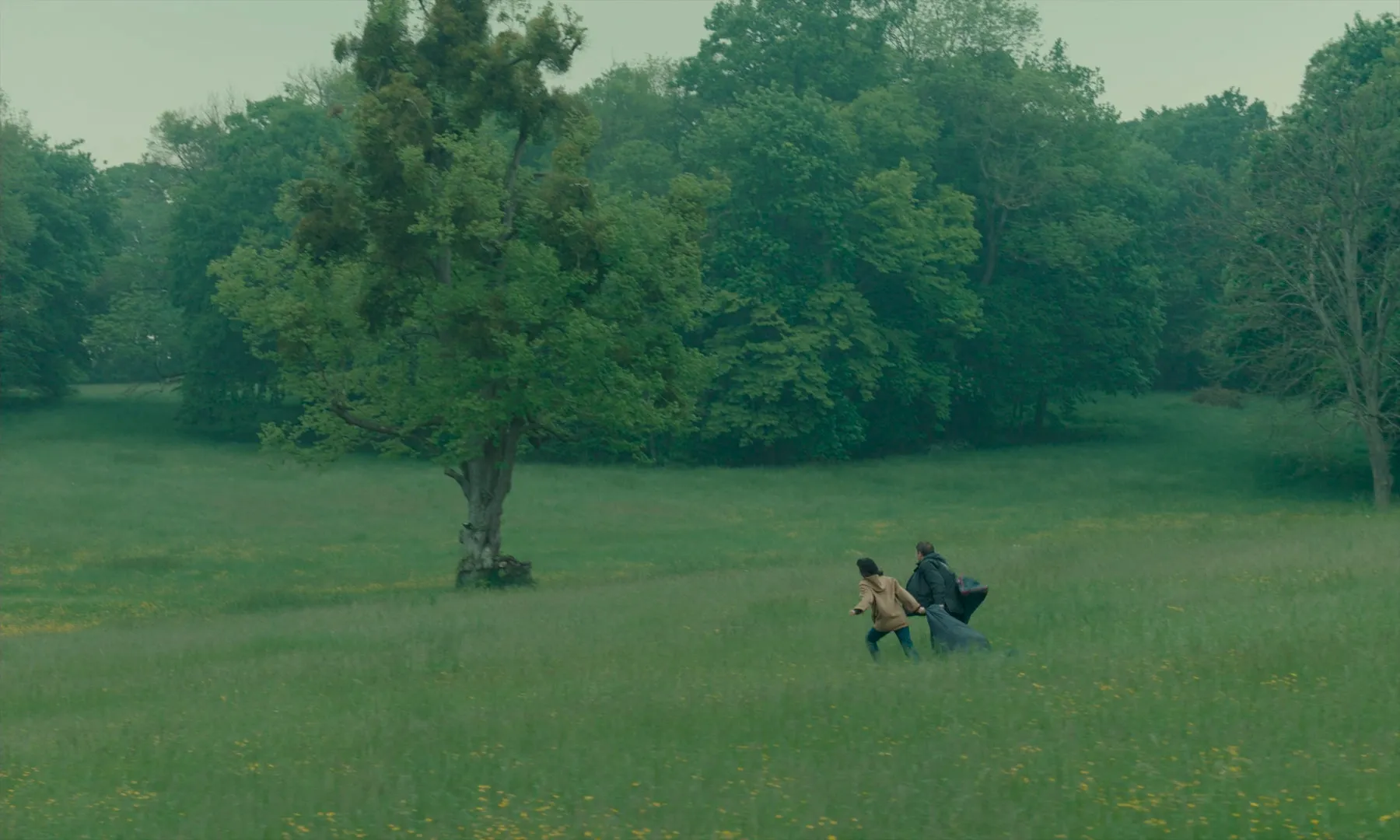Remaking your film is a daring, almost confrontational act for a filmmaker, especially when the original, like Kiyoshi Kurosawa’s 1998 Serpent’s Path, is already known for its stark, minimalist approach to the revenge thriller. Kurosawa’s latest French-language reworking of the same story does more than just translate the dialogue; he transplants the narrative into a new cultural and cinematic world, replacing Japan’s harsh industrial locations with the restrained elegance of Parisian surroundings.
At its core, the film is a revenge story centered on Albert (Damien Bonnard), a bereaved father trying to discover the truth about his young daughter’s tragic murder. Serpent’s Path explores the psychological toll of vengeance, the ambiguities of morality, and how trauma reshapes human relationships. It is more than just a search for justice.
The film adheres to classic genre patterns (kidnappings, interrogations, and mounting violence) as a revenge thriller. Still, Kurosawa’s touch adds psychological and symbolic depth that enriches the material. Kurosawa is well-known for his ability to bridge the gap between genre filmmaking and cerebral introspection, and he has built a career investigating the darker aspects of human conduct and societal collapse.
Fans of his previous work may approach Serpent’s Path with specific expectations: precise direction, disturbing tension, and existential dread. On the other hand, this French reinterpretation twists such expectations by merging Kurosawa’s particular tastes with a European arthouse aesthetic, resulting in a work that feels familiar and strange.
Plot Overview: A Twisting Path of Revenge and Ambiguity
Serpent’s Path follows the grim journey of Albert (Damien Bonnard), a distraught father whose life has been overtaken by the brutal death of his eight-year-old daughter at its heart. Kiyoshi Kurosawa twists what could have been a conventional tale of vengeance by introducing Sayoko (Ko Shibasaki), a Japanese psychiatrist with mysterious motives.
Sayoko doesn’t just accompany Albert on his mission; she molds it, serving as both an accomplice and a potential manipulator, her chilly demeanor starkly contrasting Albert’s raw, unrestrained grief. Together, they launch a harsh kidnapping and questioning operation to uncover a child trafficking scheme linked to Minard, a secretive corporate entity.
The plot begins with the kidnapping of Laval (Mathieu Amalric), a Minard accountant whose unassuming exterior hides his alleged complicity in horrible crimes. Laval, chained in a grim warehouse, becomes the first piece in a puzzle that becomes more chaotic and brutal as Albert and Sayoko’s inquiry spins out of control. Each suspect apprehended, whether guilty or not, reveals deeper layers of deception and ends up pulling more people into the conflict.
However, as the body count climbs, the film resists providing easy explanations. Sayoko’s role is particularly intriguing; her detached manner and cryptic acts suggest an end game beyond Albert’s revenge role. Is she a skilled manipulator, or is her engagement a bizarre type of therapy for her suffering partner in crime?
Kurosawa’s remake stands out against the sparse, stripped-down tone of his 1998 original. The French-language translation takes a more layered and theatrical approach. In contrast, the original film relied on stark industrial scenes and sparse dialogue to evoke a terrifying sense of trial.
Sayoko’s character, converted from a male mathematician in the original to a female psychiatrist here, adds a new dimension to the story, introducing psychological complexity and a gendered dynamic that feels especially relevant in today’s cinematic scene.
Furthermore, the move from Japan to France reshapes the cultural environment, turning the corporate and moral decay at the story’s core into a mirror of European fears about power, exploitation, and violence. In many ways, this recreation feels less like a retread and more like Kurosawa’s attempt to examine his material from a fresh perspective.
Characters and Performances: A Labyrinth of Motives and Morality
Albert, played with raw ferocity by Damien Bonnard, is at the core of Serpent’s Path. Albert is more than just a bereaved parent; he is a man dissolving beneath the weight of his grief, his humanity eroding as vengeance becomes his main purpose. Bonnard’s portrayal is a masterclass in emotional instability, with every gesture and expression ranging from desperation to barely contained wrath.
There’s an almost animalistic element to how he moves through the story. As the film goes on, it becomes evident that Albert’s pursuit of justice converts him into something far more horrible than the men he wants to punish. Bonnard conveys Albert’s moral degradation with unsettling precision, making him a sad figure whose acts are horrible yet heartbreakingly believable.
Albert is opposite Sayoko, played by Ko Shibasaki, whose enigmatic presence adds to the film’s tension. Sayoko is Albert’s collaborator and an impossible puzzle in her own right. Shibasaki’s performance is all about restraint—her chilly, calm façade conceals a vast reservoir of mystery and, possibly, pain. As the story’s titular “serpent,” she plays a quiet but major disrupting role.
Is she manipulating Albert, or is she also a victim of the same trauma and moral chaos? Shibasaki’s portrayal of cultural displacement—both as a Japanese woman in Paris and as a figure who appears emotionally disoriented—adds a layer of estrangement that resonates deeply, especially in scenes where she interacts with Hidetoshi Nishijima’s Yoshimura, a depressive immigrant whose despair mirrors her unspoken struggles.
Mathieu Amalric’s Laval, the first link in Albert’s chain of vengeance, is a fascinating study of moral ambiguity. Amalric imbues Laval with a slippery quality—pitiful and sinister, leaving the audience to wonder whether he’s a victim, a villain, or both.
Supporting cast members like Grégoire Colin and Slimane Dazi add to the moral ambiguity of the narrative by portraying characters whose complicity in the conspiracy is as ambiguous as their roles in the broader narrative. Meanwhile, Nishijima’s Yoshimura, a side character, serves as a symbolic counterweight to Albert and Sayoko’s descent into violence—a man crushed by his circumstances but unwilling to lash out.
The relationship between Albert and Sayoko is the film’s throbbing heart, and it’s as tumultuous as it is captivating. Their relationship is built on a delicate balance of power, trust, and manipulation, with each character wielding influence over the other differently. Sayoko’s cool control tempers Albert’s ferocious energy, but as the film unfolds, it becomes evident that she may be pulling strings.
Their collaboration is less about partnership and more about necessity, creating tension that leaves the viewer wondering who truly has control. Kurosawa’s script does not provide easy answers. Still, the performances ensure that the tension between these characters feels electric, even in the quietest moments.
Directorial Choices: Kurosawa’s Evolving Vision
Kiyoshi Kurosawa’s decision to revisit Serpent’s Path 25 years after its original release feels less like a retread and more like an intriguing self-reflection exercise. The 1998 adaptation was a stripped-down yakuza drama. It was a minimalist exercise in revenge storytelling that seemed raw and urgent, much like the industrial wastelands it was set in.
Kurosawa’s French-language remake swaps simplicity for a more polished, deliberate approach, reframing the story as a meticulously crafted revenge thriller with psychological implications. It’s a stylistic evolution that reveals a director who values depth and complexity, even if the original’s stark effect is softened.
Narratively, Kurosawa takes an “action first, explanation later” approach, plunging the audience into Albert and Sayoko’s objective before fully explaining their motives until the story requires it. This approach adds tension and urgency to the early scenes, particularly the savage kidnapping of Laval. Still, it risks losing the audience in its maze of turns and ambiguity.
While certain plot twists add to the narrative’s moral complexity, others feel like superfluous distractions, adding layers of complication without always progressing the story’s emotional core. However, the frequent change of perspective and allegiance reflects the characters’ uncertainty, making the experience purposefully disorienting.
Moving the story to France provides a new cultural viewpoint on Kurosawa’s exploration of violence and morality. The European end transforms the narrative into something more layer, combining Kurosawa’s Japanese tastes with a particular French arthouse flair.
Whereas the original conveyed the cold cruelty of yakuza norms, this remake leans toward European concerns about institutional corruption and moral decline, particularly via the prism of corporate collaboration. Kurosawa creates a film that feels as much about systemic violence as it is about personal vengeance, expressing bigger cultural worries in a way that resonates with both the past and the present.
Themes and Symbolism: A Labyrinth of Grief, Deception, and Alienation
Serpent’s Path is a meditation on revenge and how it corrupts the soul at its very core. Albert’s unique preoccupation with avenging his daughter’s murder serves as both a source of purpose and his undoing. His grief is palpable, but it has been weaponized into a terrible force that is gradually stripping him of his humanity.
Kurosawa depicts revenge as a circular, self-perpetuating trap, with Albert’s moral deterioration mirroring that of the men he pursues, blurring the line between victim and offender. The farther he delves into his search for justice, the more he loses sight of what justice means. It’s a theme that feels especially relevant in today’s cultural landscape, where the need for vengeance frequently overshadows true settlement.
Sayoko, who represents the serpentine theme that lends the film its namesake, is central to this moral quandary. Ko Shibasaki’s portrayal imbues Sayoko with a quiet menace, her calculating manner as slippery and unreadable as a serpent. Her role in Albert’s journey is purposefully ambiguous. As both collaborator and manipulator, she appears to guide him down a path of ruin while lingering just out of the audience’s full understanding.
The “serpent’s path” becomes a metaphor for the complexities of moral ambiguity, with each choice resulting in a greater entanglement in violence and confusion. Sayoko’s presence is both seductive and frightening, a reminder that even the most controlled exterior can conceal a labyrinth of ulterior motives.
Particularly in Sayoko’s experience as a Japanese expatriate in France, the theme of cultural alienation runs discreetly through the narrative. Her estrangement from her surroundings is similar to that of Yoshimura, a secondary but significant character who feels crushed by the weight of displacement.
Both characters symbolize a sense of emotional and cultural exile, which adds to the film’s larger themes of detachment. Their adventures shed light on how trauma, whether personal or cultural, separates people and leaves men seeking purpose in unexpected and often unfriendly situations. This strand of alienation provides a devastating undercurrent to the film, making it about identity and belonging as much as vengeance.
Visual and Technical Elements: Crafting a Bleak and Unsettling World
Alexis Kavyrchine’s cinematography contributes significantly to the atmosphere of Serpent’s Path, mixing stark precision with a sense of alienation. His frequent use of wide angles creates an emotional distance that matches the characters’ disengagement from their morality.
These compositions have an almost clinical feel, placing Albert and Sayoko as little, isolated individuals against grim, industrial backdrops that swallow them whole. With its limited color palette and harsh lighting reinforcing the oppressive weight of the narrative, the film’s visual language is bleak yet deliberate. The settings—abandoned warehouses and sterile metropolitan environments—are more than just physical spaces; they are extensions of the characters’ shattered psyche.
The sound design heightens the tension by employing spooky minimalism to keep the audience on edge. Sparse, unnerving soundscapes throb in the background, creating an almost subconscious uneasiness that lingers even in quieter moments. Like the film, the score is restrained yet effective, punctuating sequences with subtle, discordant tones that emphasize the psychological unease that permeates the story. It does not overpower but rather lingers like an unshakeable afterthought.
Kurosawa’s technical approach to timing and repetition also plays a significant role. The deliberate pacing drives the audience to accept the characters’ decisions, heightening the sense of dread as events unfold. Certain sights, like Albert’s grainy video footage or the strangely mesmerizing presence of a rotating Roomba, appear throughout the film, becoming almost nightmarish in their repetition. These components highlight the cyclical nature of revenge and men, hammering home the film’s themes in subtle yet unsettling ways.
Conclusion: A Stylish Yet Uneven Exploration of Revenge and Morality
Serpent’s Path is an intriguing, albeit flawed, meditation on revenge and the moral ambiguity that comes with it. Its piercing performances—particularly Damien Bonnard’s raw representation of grief and Ko Shibasaki’s chilly, enigmatic turn—provide psychological depth long after the credits have rolled.
Kiyoshi Kurosawa’s creative flourishes, from Alexis Kavyrchine’s distant photography to the unnerving sound design, raise the film above the level of a traditional revenge thriller. However, its deliberate pace and often complicated developments may challenge some viewers’ patience, leaving the story feeling more cerebral than emotionally resonant.
For long-time Kurosawa fans, Serpent’s Path is an interesting progression of his previous work, merging his minimalist beginnings with a more polished, arthouse sensibility. Casual viewers should approach this experience cautiously: it is a grim, slow-burning thriller that stresses atmosphere and ambiguity over catharsis.
Fans of psychological thrillers will appreciate its thematic depth and moral complexity. It’s not an easy film, but those prepared to connect with its darker themes and deliberate storytelling will find plenty to explore.
The Review
Serpent's Path
Serpent's Path is a disturbing, elegant remake of Kiyoshi Kurosawa's 1998 thriller that blends psychological depth with moral ambiguity. Anchored by Damien Bonnard's visceral performance and Ko Shibasaki's intriguing presence, the film delves into the corrosive ramifications of revenge with disturbing precision. While its deliberate pacing and intricate twists may turn off some viewers, its thematic richness and technical expertise make it a thought-provoking experience for arthouse and psychological cinema fans.
PROS
- Strong, layered performances, especially from Damien Bonnard and Ko Shibasaki.
- Thought-provoking exploration of revenge, trauma, and morality.
- Stylish cinematography that heightens emotional distance and tension.
- Unsettling sound design and a minimalist score that complements the narrative.
- A fresh cultural perspective by relocating the story to France and reimagining key characters.
CONS
- Deliberate pacing that may feel slow or overly drawn out for some viewers.
- Convoluted twists that occasionally detract from the emotional resonance.
- Limited emotional payoff due to an emphasis on ambiguity.
- The grim tone may alienate audiences looking for more cathartic or conventional revenge narratives.
- Lacks the raw immediacy of the 1998 original.




















































